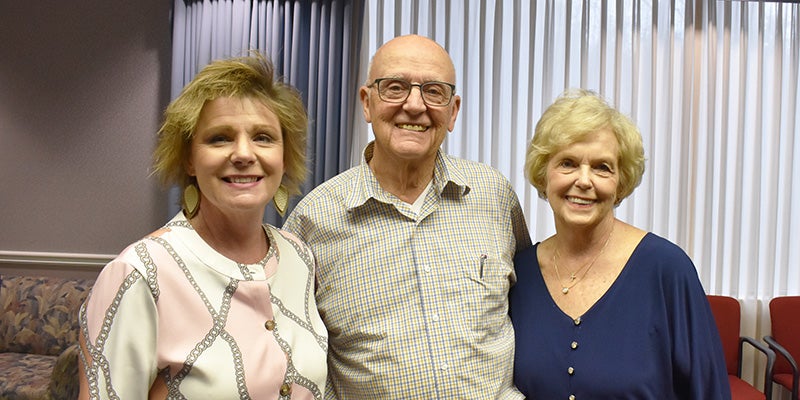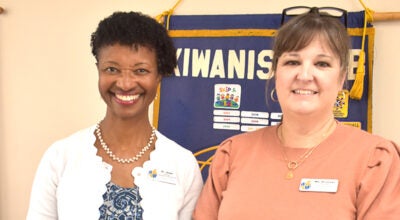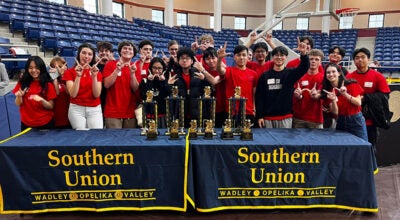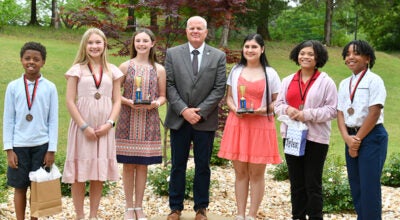Edmund’s adventure on the Chattahoochee
Published 9:30 am Saturday, March 4, 2023
|
Getting your Trinity Audio player ready...
|
WEST POINT — During Thursday’s noon hour meeting of the West Point Rotary Club, long-time member Edmund Glover had the program and gave a very entertaining talk about a Huckleberry Finn- type trip he and some close friends took down river in the summer of 1954. Instead of the Mississippi, it was the Chattahoochee, but five boys in their teens would have an adventure they’d fondly remember for many years to come.
Edmund was 15 at the time. Joining him were West Point High School friends Luverne “Pooch” Henson, Jimmy Pearson, Wallace Wright and Albert Johnson. Their Sunday school teacher, Frazier Albright, accompanied them.
The boys were active in Boy Scouts and had recently gone camping in the Okefenokee Swamp in southeast Georgia. They thought it would be a lot of fun if they could follow it up with a four-day trip along the river from Columbus to Apalachicola, Florida. They would make the journey in three motorboats. Edmund had a 12-foot boat with a five-and-a-half horsepower engine. Jimmy Pearson had similar-size boat with a 10-horsepower engine, and Albert Johnson had a 14-foot boat with a 10 hp motor.
The group planned it for several days and talked it over with their dads. All were in agreement, and a date for the trip was set. Edmund’s dad, Cliff Glover, drove them to Columbus in a station wagon hauling a flatbed trailer with the three boats.
“It’s 280 miles by road from Columbus to Apalachicola,” Glover said. “I’m sure it’s longer by river. The Chattahoochee, and especially the Apalachicola, are winding streams. We took with us enough food for four days. We ate the fresh food on the first day and had canned food for the rest of the trip.”
Just after putting in at Columbus, Edmund quickly found out that his boat was the slowest of the three. That wouldn’t be a big problem since the group was heading in one direction and were planning to make approximately 100 miles each day. They’d make camp along the river near a place they could walk for gas for their outboard engines.
The first obstacle they’d face was a pontoon bridge not far south of Columbus. It connected the east and west banks of the river for Fort Benning. It was imposing, but they found a way to safely pass under it.
“I was glad there was no big truck or tank crossing it at the time,” Glover said.
With the river current behind him, Glover’s boat would reach speeds of up to 10 miles per hour. The other boats were a bit faster.
“We had a map with us,” Glover said. “We knew where we were when we passed under a bridge. Since it was June, the days were longer, and we could spend more time on the river.”
They made camp on the first night on a sand bar on the Georgia side of the river. They were in the Eufaula-Georgetown area and had no trouble finding gas. It wasn’t much of an expense back then since it sold for 26 cents per gallon.
There was no Lake Eufaula (a.k.a. Walter F. George Reservoir) at the time, and the camp site was close to a bridge linking the two cities. Late in the afternoon, Glover went to fetch some gas from a local station.
“I got up on the bridge and could see a gas station in the distance,” he said. “I filled up two cans and walked back to the camp site.”
It’s a good thing he was wearing a pith helmet to shield him from the sun. On the way back, he conked his head on a concrete beam underneath the bridge. It knocked him flat on his back. Luckily, he didn’t spill any gas and suffered no injury. It was more embarrassing for him than anything else, and he no doubt was kidded by his friends for being a bit clumsy.
On the second day down the river, the boys passed the Walter F. George Dam, which was then under construction. Late in the day, they set up camp on the Georgia side. It was near a cow pasture, and they could see a windmill in the distance. After they’d set up their three tents, they started walking to the windmill in hopes of getting some clean water. About halfway across the cow pasture, they noticed a truck heading their way. A farmer was driving it. He stopped to ask if there was anything he could do for them. They had some water jugs with them and asked if they could get some fresh water. No problem, he told them, and he drove them back to his farm house near the river.
They appreciated the friendly gesture, but they got a bit antsy when he told them he had always stayed away from the spot where they were camping.
“Too many snakes and other critters down there,” he told them.
It didn’t make them feel any better when they heard the shrill cry of a wildcat that night.
“The next day we were back on the river heading south,” Glover said.
It was the third day of the trip, and the river widened to become Lake Seminole. This is a U.S. Army Corps of Engineers project that was approved by Congress in 1946. The impoundment was created by the Jim Woodruff Dam, which was completed in 1952.
When heading south on the river, any boat must go through a lock or portage around the dam. The boys decided it would be fun to have their boats lowered in the lock to reach the other side.
It was a near disaster for one boat in the group. To keep the boat still as the water level falls inside the lock, it’s necessary to tie the boat to the lowering lock. One of the boys made the mistake of tying his boat to a ladder. This caused the boat to tilt as the boat dropped. The guys on the boat saw what was happening and quickly took corrective action, untying the boat from the ladder and tying up in the right place.
All boats made it safely thorough the lock, but a short distance downstream on the Apalachicola River, they ran into an intense rainstorm.
“We all got soaking wet,” Glover said. “We spotted a sheltered place on the side of the river and went there to wait out the storm.”
They spent a wet, uncomfortable night on the east bank of the Apalachicola. Spirits picked up on the next day when they took a fork in the river and journeyed downstream along the Chipola River to a fish camp.
“We got some gas there,” Glover said.
The Chipola rejoins the Apalachicola and winds back and forth through a very bland, remote landscape toward the coast.
“When you get past Blountstown, there’s no town along the river until you get to Apalachicola,” Glover said.
Being in Apalachicola was one of the most fun parts of the trip. The guys tied up their boats to a dock where fishing boats came and went to coastal waters.
“We asked if we could contact the local Boy Scouts, and they directed us to a Scoutmaster,” Glover said. “We asked him if there was a place we could camp for the night, and he led us to a city park. He told us we could put up our tents there or could stay in a nearby Girl Scout house that wasn’t being used at the time. We also found out about some fun places to go and things to do.”
Glover called home to speak to his dad.
“It was the first time I had talked to him since he put us out at the boat ramp in Columbus,” he said. “I told him that everything had went well, and we made arrangements for him to pick us up the next day.”
The boys had made the Florida coast but saw no beach. They asked about that and was told it was because of barrier island named St. George that was not far away from shore and extended about 30 miles in an east-west direction. They were told that the island had a really nice beach on the Gulf of Mexico side. They boys piloted their boats through some choppy water to St. George and walked a couple of hundred yards to the other side.
“It was absolutely the most beautiful beach I’ve ever seen,” Glover said. “There was beautiful white sand in both directions as far as you could see.”
There was only one building on the island at the time. Since then, a bridge has been built and that beach area has lot of hotels and condos.
The boys tried their luck at fishing along the coast. Glover was excited to land one, but their guide told him it was a saltwater catfish and was not good to eat.
The three motorboats made their way safely across to the mainland, and the six-member group awaited Mr. Glover’s arrival. He came down in the station wagon with the empty flatbed. When he got there, the three motorboats were loaded onto the flatbed, and the group piled into the station wagon for the trip back home.
“We made one stop in Eufaula to eat at an historic downtown hotel,” Glover said.
A member of the club asked Glover if he had taken any photos on the trip.
“No. Smart phones didn’t have cameras in 1954,” he joked.
Another member of the club asked him if they had seen any alligators on their trip.
“They were probably in the river at the time, but I don’t remember seeing any of them,” he said.
“When I look back on it,” he said. “I find it absolutely amazing that none of us got sick. There were no pollution controls back then. Raw sewage was getting in the river from everywhere. We washed all our plates and cooking utensils in river water.”
There is a photo of the guys on this trip in a June 1954 issue of The Valley Daily Times-News. A reporter for the Eufaula paper took it an mailed a copy of it to the Times.
“In the caption under the photo, they misspelled my name,” Glover said. “They called me Edmo Glover. A neighbor of mine called me that for I don’t know how long.”





